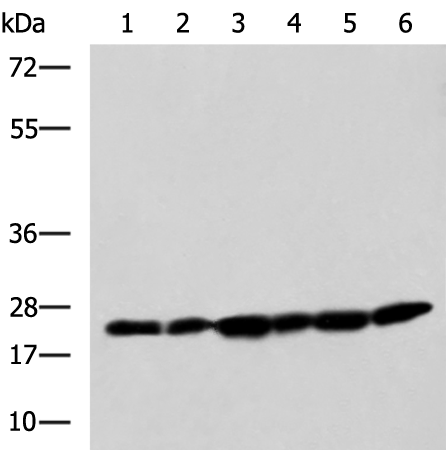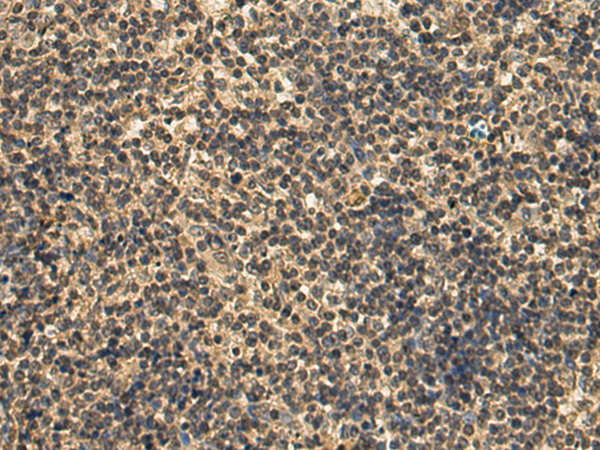

| WB | 1/500-1/1000 | Rat |
| IF | 咨询技术 | Rat |
| IHC | 1/50-1/100 | Rat |
| ICC | 技术咨询 | Rat |
| FCM | 咨询技术 | Rat |
| Elisa | 咨询技术 | Rat |
| Aliases | PIMT |
| WB Predicted band size | 25 kDa |
| Host/Isotype | Rabbit IgG |
| Antibody Type | Primary antibody |
| Storage | Store at 4°C short term. Aliquot and store at -20°C long term. Avoid freeze/thaw cycles. |
| Species Reactivity | Human, Mouse, Rat |
| Immunogen | Fusion protein of human PCMT1 |
| Formulation | Purified antibody in PBS with 0.05% sodium azide and 50% glycerol. |
+ +
以下是关于 **Pulmonary Surfactant Associated Protein D (SP-D) 抗体** 的参考文献示例(注:文献为示例性概括,具体内容需查阅原文):
---
1. **文献名称**:*"Surfactant Protein D in Innate Immunity: A Dual Role in Host Defense and Inflammation"*
**作者**:Kishore U, Greenhough TJ.
**摘要**:探讨SP-D通过结合病原体相关分子模式(PAMPs)调节先天免疫的机制,并利用抗SP-D抗体阻断实验证明其抑制过度炎症反应的双向作用,提示其作为治疗靶点的潜力。
2. **文献名称**:*"Serum Surfactant Protein D as a Biomarker for Chronic Obstructive Pulmonary Disease (COPD) Severity"*
**作者**:Sorensen GL, Hjelmborg JVB.
**摘要**:通过ELISA(使用SP-D特异性抗体)检测COPD患者血清SP-D水平,发现其浓度与肺功能下降和病情进展显著相关,提示其作为疾病预后标志物的价值。
3. **文献名称**:*"Autoantibodies Against Surfactant Protein D in Idiopathic Pulmonary Fibrosis"*
**作者**:Takahashi H, Fujishima T.
**摘要**:研究特发性肺纤维化(IPF)患者体内抗SP-D自身抗体的存在,利用免疫印迹法(抗人SP-D抗体)证明其与疾病活动性相关,可能参与肺组织损伤机制。
4. **文献名称**:*"Surfactant Protein D Modulates Viral Infection by Binding to Glycoproteins and Activating Phagocytosis"*
**作者**:Crouch EC, Hartshorn KL.
**摘要**:通过抗SP-D抗体阻断实验,验证SP-D直接结合流感病毒血凝素蛋白并增强巨噬细胞吞噬功能,阐明其在抗病毒免疫中的关键作用。
---
如需具体文献,建议通过 **PubMed/Google Scholar** 检索关键词(如 *SP-D antibody biomarker/therapeutic/immune function*)或查阅综述(如 *Kishore U* 团队关于SP-D的系列研究)。
Pulmonary surfactant-associated protein D (SP-D) is a member of the collectin family, primarily synthesized and secreted by alveolar type II cells and Club cells in the respiratory epithelium. It plays a critical role in innate immunity, functioning as a pattern recognition molecule that binds to pathogen-associated molecular patterns (PAMPs) on microbes, including bacteria, viruses, and fungi. SP-D facilitates microbial agglutination, opsonization, and clearance by immune cells, while also modulating inflammatory responses to prevent tissue damage. Structurally, it consists of an N-terminal collagen-like domain, a coiled-coil neck region, and a C-terminal carbohydrate recognition domain (CRD), forming multimeric complexes essential for its functional activity.
Antibodies targeting SP-D are widely used in research and diagnostics to investigate its expression, localization, and role in pulmonary diseases. For example, SP-D levels in serum or bronchoalveolar lavage fluid are studied as biomarkers in chronic obstructive pulmonary disease (COPD), acute respiratory distress syndrome (ARDS), and idiopathic pulmonary fibrosis (IPF). Immunohistochemistry, ELISA, and Western blotting with anti-SP-D antibodies help assess its distribution in tissues or biological fluids. Additionally, these antibodies aid in exploring SP-D's involvement in immune regulation, host defense, and its potential therapeutic applications. However, variations in antibody specificity (e.g., clone-dependent epitope recognition) require rigorous validation to ensure reliable results. Cross-reactivity with other collectins or degradation products must also be considered in experimental design.
×